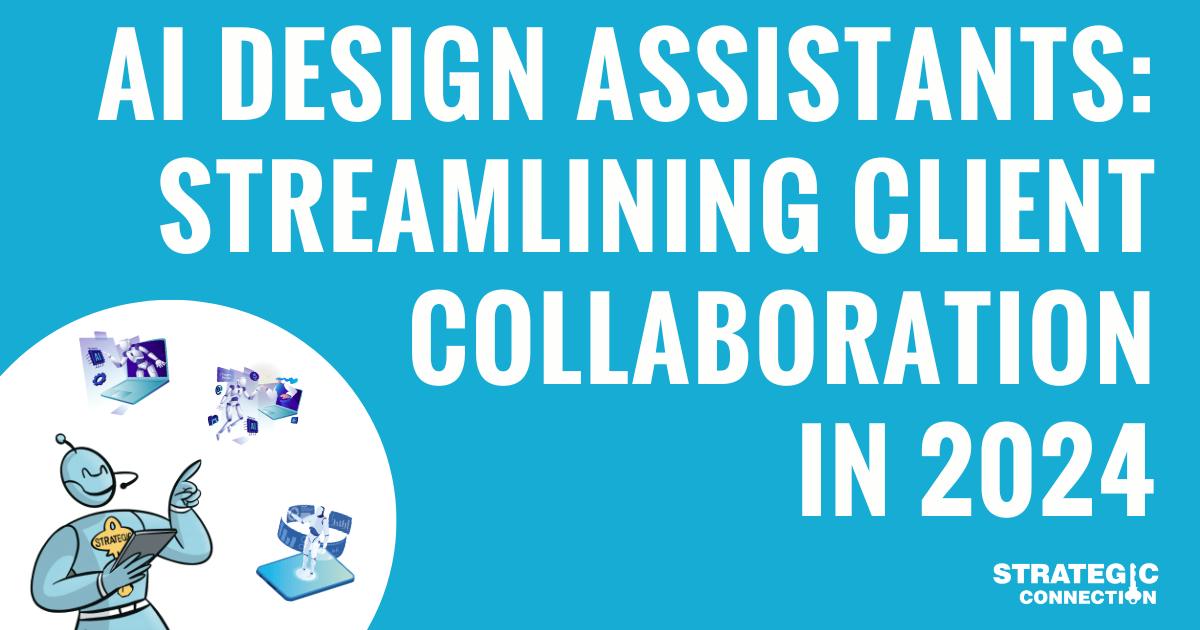
AI Design Assistants: Streamlining Client Collaboration in 2024
Posted by: Ali Jaffar Zia
March 6, 2024
Design and AI - What’s the connection?
Design and AI share a profound and symbiotic connection, shaping the landscape of creativity and innovation. At the intersection of these two realms lies a dynamic synergy that transcends traditional boundaries. With its computational prowess, AI augments the design process by offering intelligent insights, streamlining workflows, and even generating creative elements.
Designers harness the power of AI to enhance efficiency, from automating repetitive tasks to receiving data-driven suggestions that elevate their creations. This union goes beyond mere automation; it's about infusing intelligence into the fabric of design, enabling a harmonious blend of human ingenuity and artificial intelligence. As we navigate the technological landscape, the connection between design and AI is not just a collaboration; it's a transformative fusion that propels creative endeavors into uncharted territories.

In design, the relationship between creators and clients is paramount. In 2024, the integration of AI-powered design assistants has emerged as a transformative force, significantly streamlining the collaboration process and elevating the design experience for both designers and clients.
The Evolution of Collaboration
Traditionally, the design collaboration process often involved a series of back-and-forths, lengthy email exchanges, and revisions. Enter AI-powered design assistants, which act as intelligent facilitators, helping bridge the gap between designers and clients seamlessly.
Efficient Communication
AI design assistants leverage natural language processing (NLP) algorithms to interpret client feedback and queries accurately. This eliminates ambiguity, allowing for clearer communication between designers and clients. For instance, a designer working on a branding project can receive feedback from a client, and the AI assistant can discern nuanced preferences, such as the desired mood, color palette, or typography.
Smart Design and AI Suggestions
One of the standout features of AI design assistants is their ability to offer intelligent design suggestions based on historical data, current trends, and client preferences. By analyzing vast datasets, these assistants can recommend elements that align with the client's brand identity, ensuring a more cohesive and on-target design from the outset.
Real-Time Collaboration Platforms
AI has enabled the development of real-time collaboration platforms where designers and clients can interact seamlessly. These platforms integrate chatbots and virtual assistants that instantly respond to queries, reducing turnaround times and expediting decision-making processes. This is particularly beneficial for projects with tight deadlines. Here are 10 examples of real-time collaboration platforms.
Figma:
Figma is a cloud-based design platform that allows real-time collaboration among designers. Multiple team members can simultaneously work on the same project, making it a powerful tool for UI/UX design and prototyping.
Miro:
Miro is a collaborative online whiteboard platform that enables teams to work together in real time. It's versatile, supporting various collaborative activities such as brainstorming, diagramming, and project planning.
As part of the Microsoft 365 suite, Teams facilitates real-time collaboration with features like chat, video conferencing, and document sharing. It integrates seamlessly with other Microsoft applications for efficient teamwork.
Slack is a popular messaging and collaboration platform that offers real-time communication through channels, direct messages, and file sharing. It enhances team connectivity and project coordination.
Asana is a project management tool allowing teams to collaborate on tasks and projects in real time. It provides a centralized platform for planning, tracking, and managing work.
Google Workspace provides collaborative tools, including Google Docs, Sheets, and Slides. Multiple users can edit documents simultaneously, enabling real-time collaboration on various projects.
Notion is an all-in-one workspace that supports real-time collaboration on notes, documents, and project management. It combines the functionalities of wikis, task management, and collaboration tools.
While primarily known for video conferencing, Zoom also offers real-time collaboration features such as screen sharing and annotation. It facilitates interactive discussions and collaborative work sessions.
Trello is a visually-oriented project management tool that utilizes boards, lists, and cards. It supports real-time collaboration, allowing team members to update and track project progress continuously.
Airtable is a flexible collaboration platform that combines a spreadsheet's simplicity with a database's power. It allows teams to collaborate on structured data, making it suitable for various use cases.
These platforms foster efficient communication, coordination, and productivity among team members, making them essential tools for modern collaborative work environments.
Personalized Design Experiences:
Every client has a unique vision for their project. AI design assistants excel at understanding individual preferences, ensuring that the design process remains personalized. For instance, the assistant can adapt layouts, color schemes, and content structures based on user data and client specifications in web design, creating a tailored user experience.
Enhanced Project Management:
Beyond the creative aspect, AI design assistants contribute to efficient project management. They can automate routine tasks, schedule milestones, and even predict potential bottlenecks in the design process. This allows designers to focus on the creative aspects of their work, confident that project management is in capable hands.
Examples in Action:
- Adobe's Sensei: Adobe Sensei integrates AI and machine learning into its design tools. It understands the intent behind design choices, offering automated suggestions and reducing the need for extensive manual adjustments.
- Figma's Collaborative Design: Figma's collaborative design platform utilizes AI to facilitate real-time collaboration. It streamlines the feedback loop, ensuring that changes are reflected instantly enhancing communication between designers and clients.
- Canva's Design Assistant: Canva employs AI to provide design suggestions based on user preferences and past designs. This assists users in creating visually appealing content effortlessly.
Conclusion:
AI design assistants catalyze efficiency, creativity, and client satisfaction in the ever-evolving design landscape. As we embrace 2024, the collaborative potential between designers and clients is expanding, thanks to these intelligent tools. By leveraging the power of AI, designers can ensure that every project is a harmonious blend of creativity and client vision, setting a new standard for design collaboration in the digital age.
More blogs you may like to read:
LEARN MORE ABOUT STRATEGIC CONNECTION’S DIGITAL MARKETING SERVICES AND GET A QUICK QUOTE. 
